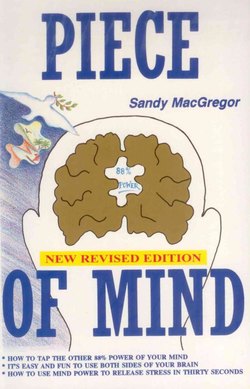Читать книгу Piece Of Mind - Sandy MacGregor - Страница 13
На сайте Литреса книга снята с продажи.
Representational Styles
ОглавлениеWe all learn with all our senses, but often one of our senses dominates. From the science of Neurolinguistic Programming (NLP) we find that we learn and communicate with all our senses – sight, hearing, smell, taste, touch. These representational styles are: visual, auditory and kinesthetic. Most of us favour one over the others – especially when we are stressed.
For example some people are good listeners and can readily and easily absorb information from listening. Others are more visual and learn best from being able to see something demonstrated. Some are kinesthetic, which means they learn best from actually doing, or experiencing, in much the same way as you are doing now, by reading this book and doing the exercises yourself. If you love to learn by getting involved,
then perhaps you would find greater benefit in actually attending discussion groups or seminars. I am a particularly good auditory person – I quite readily absorb information through my ears. However, when I was at university, I didn't learn from listening. The lecturer was busy writing on the blackboard as well as talking. I concentrated on copying down the notes (and daydreaming as well). I'd look at those notes a day or a week later but I didn't recognise the material! It was not until I actually went over the notes again and “experienced” them that I started to absorb the information.
Most people are dominated by one or two of the three primary representational styles, being: auditory, visual or kinesthetic.
A rough average of how people learn is:
-50-60% of learning takes place via the most dominant representational style
-30-40% the next most dominant
-10-20% the least dominant
It can be quite frustrating in a marriage situation when one partner is visually dominant and one is auditory dominant. This is the case in my family. My wife is visual and sometimes has selective hearing when I'm talking. This is not a criticism – I can certainly be the same – it's quite natural. Often I will explain something and think that Sandra is listening and that she has got it. Later Sandra may claim not to know about it. It might be a lesson to me about my communication skills, or timing, but it certainly can create misunderstanding and communication breakdown. It can be quite frustrating, there's no doubt about it (we now have an agreement that if I want Sandra to take some action on what it is that I have said then I must write it down, or she repeats it back to me. It seems to work!).
My younger son is very kinesthetic. He used to have stories read to him, which he loved. But what he would do when the story was being read was play. He'd play with his cars, with his planes, whatever it might be, and he'd run around the room – but make no mistake – he knew every word that was being said at any time. He knew exactly where the story was up to. He was probably processing kinesthetically, and being auditory as well – he needed to be able to do some-thing whilst listening. Now it can be frustrating reading to a kid when you think he is not paying attention. “Pay attention, listen to the story! You wanted me to read to you, do you want to hear it or not?!” ... but he heard every word!
Many school teachers come across kinesthetic kids and in some instances they are labelled hyperactive. I have even heard of situations whereby children have been given drugs to calm them down! There are other ways of teaching these children. It is very important if you are a teacher to know whether your students are visual, auditory or kinesthetic. When teaching any group of people these three representational systems always need to be covered.
